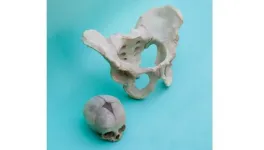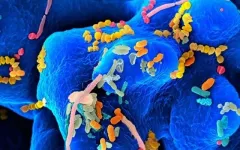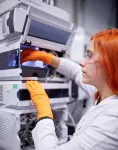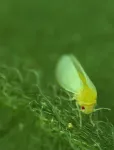Where do the gender differences in the human pelvis come from?
A comparison with chimpanzees provides surprising insights
2021-03-25
(Press-News.org) Fossil remains of the human pelvis are rare because the pelvic bones do not preserve very well. Therefore, it has remained unclear when human sex differences in the pelvis evolved: jointly with upright walking, or later, together with the large human brains. "We have discovered that the pattern of sex differences in the human pelvis is probably much older than previously thought", says evolutionary biologist Barbara Fischer.
A team of biologists from the University of Vienna, the KLI for Evolution and Cognition Research, and the University of Calgary compared pelvic sex differences in humans with those in chimpanzees, the most closely-related living species to modern humans. Chimpanzees have much easier births than humans, because their fetuses are smaller. "We analyzed 3D data of pelves for these two species and found that they show the same pattern of sex differences, despite large overall species differences," says Fischer. Yet, the magnitude of the differences was only half as large in chimpanzees, compared to humans. The striking similarity of the pattern of pelvic sex differences in humans and chimpanzees strongly suggests that it was already present in the common ancestor of the two species. This implies that all the extinct hominin (human-like) species, including e.g., the Neandertals, probably had the same pattern.
Many mammals give birth to larger fetuses, relative to the birth canal of their mothers, compared to humans, e.g., bats and certain primates. These animals possess adaptations in their pelves to facilitate birth of large babies. At the same time, there are other mammals with tiny neonates, e.g., cats and opossums, which also have subtle sex differences in their pelves that resemble the human pattern. This suggests that these similarities in the pattern of pelvic sex differences reflect an old and evolutionarily conserved mammalian pattern. "We think that modern humans did not evolve this pattern de novo, but that we inherited it from earlier mammals that faced the same problem, namely having to give birth to relatively large fetuses," says Fischer. When our brains became increasingly large over the course of human evolution, the magnitude of pelvic sex differences was therefore able to increase rather rapidly, as the pelvic pattern and the underlying genetic and developmental machinery were already in place and did not have to evolve anew.
INFORMATION:
Publication in Nature Ecology & Evolution:
Barbara Fischer, Nicole D.S. Grunstra, Eva Zaffarini, Philipp Mitteroecker (2021)
Sex differences in the pelvis did not evolve de novo in modern humans. Nature Ecology & Evolution, in print.
DOI: 10.1038/s41559-021-01425-z
[Attachments] See images for this press release:

ELSE PRESS RELEASES FROM THIS DATE:
2021-03-25
Power converters are the little-known systems that make electricity so magical. They are what allow us to plug in our computers, lamps and televisions and turn them on in a snap. Converters transform the alternating current (AC) that comes out of wall sockets into the exact level of direct current (DC) that our electronics need. But they also tend to lose, in average, up to 20% of their energy in the process.
Power converters work by using power transistors - tiny semiconductor components designed to switch on and off and withstand high voltages. Designing novel power transistors to improve the converters' efficiency is the aim of the team of EPFL engineers. With their entirely new transistor design, based on the counterintuitive application ...
2021-03-25
University of Texas at Dallas researchers have discovered that a novel surface they developed to harvest water from the air encourages tiny water droplets to move spontaneously into larger droplets.
When researchers placed microdroplets of water on their liquid-lubricant surface, the microdroplets propelled themselves to climb, without external force, into larger droplets along an oily, ramp-shaped meniscus that forms from the lubricant around the larger droplets. The "coarsening droplet phenomenon" formed droplets large enough for harvesting.
"This meniscus-mediated climbing effect enabled rapid coalescence on hydrophilic ...
2021-03-25
The evolving science of wisdom rests on the idea that wisdom's defined traits correspond to distinct regions of the brain, and that greater wisdom translates into greater happiness and life satisfaction while being less wise results in opposite, negative consequences.
Scientists have found in multiple studies that persons deemed to be wiser are less prone to feel lonely while those who are lonelier also tend to be less wise. In a new study, published in the March 25, 2021 issue of the journal Frontiers in Psychiatry, researchers at University of California San Diego School of Medicine take the connection between wisdom, loneliness ...
2021-03-25
An analysis of adult human brain tissue reveals over 900 proteins tied to epilepsy. The brain disorder, estimated to afflict more than 3 million Americans, is mostly known for symptoms of hallucinations, dreamlike states, and uncontrolled, often disabling bodily seizures.
Led by researchers at NYU Grossman School of Medicine, the study examined molecular differences among the brains of 14 epilepsy patients and another group of 14 adults of similar age and gender who did not have the disease.
Study results showed that altered levels of brain proteins predominated in the hippocampus, a structure located deep inside ...
2021-03-25
Researchers from Charité - Universitätsmedizin Berlin and the Francis Crick Institute have developed a mass spectrometry-based technique capable of measuring samples containing thousands of proteins within just a few minutes. It is faster and cheaper than a conventional blood count. To demonstrate the technique's potential, the researchers used blood plasma collected from COVID-19 patients. Using the new technology, they identified eleven previously unknown proteins which are markers of disease severity. The work has been published in Nature Biotechnology*.
Thousands of proteins are active inside the human body at any given time, providing its structure and enabling reactions which are essential to life. The body raises and lowers the activity ...
2021-03-25
Expectant women are more likely to give birth early if they have high blood levels of a chemical used in flame retardants compared with those who have limited exposure, a new study finds.
These polybrominated diphenyl ethers (PBDEs) are used in the manufacture of furniture, carpeting, and other products to reduce flammability. Previous studies have found that the substances can leach into household dust and build up in the body where they may interfere with the thyroid, an organ that secretes brain-developing hormones. Childhood exposure to PBDEs has been linked to learning disabilities, autistic ...
2021-03-25
Millions of years ago, aphid-like insects called whiteflies incorporated a portion of DNA from plants into their genome. A Chinese research team, publishing March 25th in the journal Cell, reveals that whiteflies use this stolen gene to degrade common toxins plants use to defend themselves against insects, allowing the whitefly to feed on the plants safely.
"This seems to be the first recorded example of the horizontal gene transfer of a functional gene from a plant into an insect," says co-author Ted Turlings (@FARCE_lab), a chemical ecologist and entomologist ...
2021-03-25
Octopuses are known to sleep and to change color while they do it. Now, a study publishing March 25 in the journal iScience finds that these color changes are characteristic of two major alternating sleep states: an "active sleep" stage and a "quiet sleep" stage. The researchers say that the findings have implications for the evolution of sleep and might indicate that it's possible for octopuses to experience something akin to dreams.
Scientists used to think that only mammals and birds had two sleep states. More recently, it was shown that some reptiles also show non-REM and REM sleep. A REM-like sleep state was reported ...
2021-03-25
More than half of the opioid tablets prescribed for patients who underwent orthopaedic or urologic procedures went unused in a new study by researchers at the Perelman School of Medicine at the University of Pennsylvania. Using an automated text messaging system that regularly checked in with patients on their pain and opioid use, the study also showed that most opioids are taken within the first few days following a procedure and may not be necessary to manage pain even just a week following a procedure. The study was published today in JAMA Network Open.
"Through simple text messaging we highlight a method which gives clinicians the information they need to reduce prescribing and manage ...
2021-03-25
BOSTON - In the largest study of its kind to date, researchers at Massachusetts General Hospital, Brigham and Women's Hospital and the Ragon Institute of MGH, MIT and Harvard have found the new mRNA COVID-19 vaccines to be highly effective in producing antibodies against the SARS-CoV-2 virus in pregnant and lactating women. They also demonstrated the vaccines confer protective immunity to newborns through breastmilk and the placenta.
The study, published in the American Journal of Obstetrics and Gynecology (AJOG), looked at 131 women of reproductive age (84 pregnant, 31 lactating and 16 non-pregnant), ...
LAST 30 PRESS RELEASES:
[Press-News.org] Where do the gender differences in the human pelvis come from?
A comparison with chimpanzees provides surprising insights




